This is my entry into the Monthy Wine Writing Challenge (#MWWC14.) This month’s theme, chosen by last month’s winner, Bill of Duff’s Wines is “tradition.” I could have written more than anyone would care to read, and probably have. However, I was so inspired by this theme and the story I chose to share, I hope you bear with me and my lengthy tome. If you want to cut to the chase, the wine reviews are at the bottom, but you’ll be missing out on all the insanely interesting content in between. Just sayin.
To view the other entrants and cast your vote (for moi) please click here.
Link not working? cut and paste this url into your browser:
https://mwwcblog.wordpress.com/2015/01/27/mwwc14-time-to-vote/
———————————————–
Tradition can be ceremonial, a societal rite, a commitment between friends, a practice between professionals. Tradition can be a declaration of allegiance that marks a time and place with displays of national or cultural heritage. What is the common thread? It is ritual, it unites and establishes an identity and depending how strong the tradition, it can survive passages of time spanning centuries.
One can hardly argue that historically the strongest traditions are forged through family. The great wine dynasties of the world are the perfect illustration of tradition and how powerful it can be. It is no mistake that the most recognized names in the wine world are Gallo, Sebastiani, Mondavi. These family brands were started generations ago by their eponymous scions and to this day are still owned and operated by their progeny*. The California wine industry owes much of what it is today from the generational vision and wisdom passed through heirs who are as passionate about continuous improvement of the craft as they are their family heritage.
The growth of the wine business swelled in the 90’s and early 2000’s and a new generation of vintners who had the technology, education and drive to take the family business into the realm of multimillion dollar mega brands emerged. Most of California’s 2,000 wineries are owned by families. They are a major economic engine in the state and have an economic impact of $45.4 billion on California’s economy.** Of the top 10 wine businesses in the US, four are still family owned and operated and collectively produce over 100 million cases of wine annually.***this is Falcon Crest on steroids, and I’m not referring to Lorenzo Lamas.
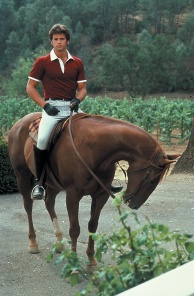
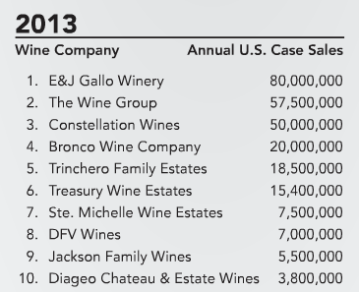
In early October, I received an inquiry from a representative of the Scotto Family Cellars. Bradley Gray is a local Sonoman who does PR for the wine industry and stalks elusive wine bloggers (it’s a small town, I’m trying to remain semi anonymous as cheap wine is not a popular subject in polite society around here and inevitably I’m going to insult the wrong person and be forced to hide out in Napa – egads.) He noted that I had ranked the Scotto Family brands, Rare Red Grape 4 Blend, $7.99 and O.V.O.C. 2012 Regio Zinfandel $8.99, as a#1 and #6 respectively on my 2014 top 10 under $10.
He proposed I meet the Scottos, 5th generation wine makers, and taste some of their other wines. Not one to turn down a party in my honor, I accepted the invitation and proceeded to work with Brad on a date and a guest list. I had never met the Scottos prior to tasting and loving their wines. I was very excited to meet these innovators of premium value wines. How do they do it? Making good wine for less than $10 is a daring and magnificent feat and I suspect, much more difficult to achieve than painstakingly creating finely crafted small lot vintages. I’m over simplifying it, but that is where my thoughts wandered.
We decided to meet at the Depot Hotel in Sonoma. Built in 1870, the Depot Hotel was originally the local hotel for passengers passing through from San Francisco. Since 1922 it has functioned as a restaurant and the environment is charming and the food delicious.
When I arrived, I was greeted by Bradley and an enthusiastic Anthony Dominic Scotto III, CEO of Scotto Family Cellars, and his younger brother Paul, the winemaker. My first impression: these brothers are rather youthful to be running a very large and rapidly growing family business. My second: they are justifiably proud and grounded in their family history. My final impression: these guys are über talented! Let’s start tasting.
After the typical Californian perfunctory chat about traffic, road conditions, variations on freeway choices and the severity of our mild weather, Anthony started to tell the family story.
Anthony and Paul’s great grandfather Salvatore Dominic Scotto started a winery in Ischia, Italy, an island on the Gulf of Naples, in 1883. In 1903, the family emigrated from Italy and settled in Brooklyn, NY. near the docks where Dominic had worked as a ship’s caulker. His sons, Leo, Anthony, Sal and Frank were taught how to make wine in 5 gallon crocks which were sold from horse drawn wagons. Dominic opened a wine store in 1909 but had to shut it down during Prohibition. After the 13 year ban, the sons reopened the store in 1934 at 318 Court St., where it has been located and operating for the past 80+ years. (Read a lovely article about the 80 year anniversary in the New York Daily News by clicking here.)
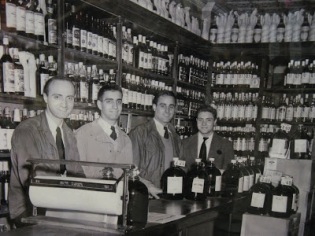
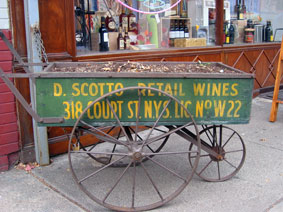

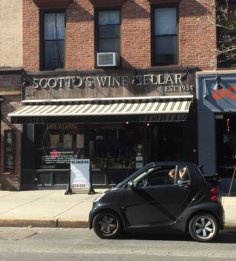
Scotto Liquors is one of the oldest liquor stores still in operation in the state of New York. The Scotto family sold the store in 1989, but the current owner, James Benedetto, still honors the family heritage and has kept with tradition by offering hundreds of wines, imported from around the world, ranging in price from $6.99 to several thousand dollars for a highly sought wine like Romanee-Conti wine from Burgundy.
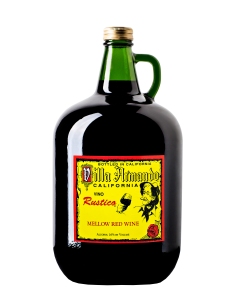
Anthony Sr. (aka A1) and his brother Sal create Villa Armando Rustico, one of the oldest US wine brands and in 1963 they decide to move West to California and buy a facility in Pleasanton that is named Villa Armando. This becomes the home to their rapidly growing wine business and the mass production of wine that paved the way for Anthony Jr. (aka A2) and subsequently Anthony the Third (aka A3) to build a family business with overall capacity of more than 300,000 cases annually and over 40 brands of wine today. In 2004, A3 opened Scotto Cellars and since 2009 the business has experienced double digit growth year over year becoming the 35th largest winery in California. They operate properties in Napa, Amador and Lodi with Paul (a U.C. Davis Viticulture & Enology graduate who worked for one of the Russian River’s premiere Pinot Noir producers) overseeing winemaking. Soon the remaining siblings came into the business (and complimentary businesses as their sister Natalie operates her own distribution company) and thus the new generation of Scottos is shaping the future of the wine industry. The work they are doing today ushers in a new era of “premium value wines” which is enabled through advancements in agricultural/production technology, an uninhibited new generation of wine drinkers and the industry’s synchronicity with social media. The Scottos are barely in their 30’s and they get it. 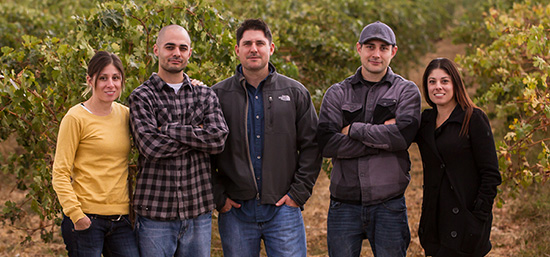
Sunday night dinners at their grandfather’s winery home was where the grand kids heard stories about their family history and their grandfather made sure they understood that the best wines are those enjoyed with family and food. A3 honored his grandfathers wishes when he ensured we ordered food to compliment the wine. (Ok they bought me a pizza and gave me a few bottles – full transparency here.) We then proceeded to taste the following wines. Some are my tried and true value wines, some are a bit splurgy, all are very well done and I do have my favorites.
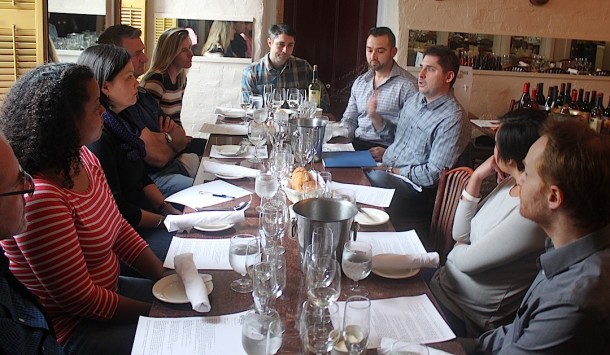
Notes: Nose tropical fruit, pineapple. First sip bright, crisp with a long finish that belied some fruit but overall dry. A pleasant, unassuming white blend that is easy drinking but well rounded, good body and balanced acid. You really can’t go wrong with any of the Rare Blend wines by the Scottos.
2012 Regio Dry Rosé, El Dorado County, CA $11.99 — CASEWORTHY!
I LOVE this Rosé. It was a damp, cold, overcast day when I tasted this wine. It instantly reminded me of summer. The bouquet won me over, fragrant, big florals and ripe fruit. The first sip was honeysuckle and fresh berries with a crisp dry finish. Dreamy. For the price, beautifully done.
2012 Steel Canyon Chardonnay, Napa, CA $15.00
This was a perplexing Chardonnay but had merit for the body and richness one would expect from a Napa Chard. Aged in New French Oak it had high acid and a velvet vanilla finish. All the right notes one would expect. To be fair, I think what threw me off is my preference for un-oaked Chardonnay of which I have become accustomed, resulting in oaked Chardonnay no longer suiting my palate (I suspect it never did to being with.)
2010 Serafina Barbera, Amador County CA $26.00
This is Paul Scotto’s winery owned and operated independently of the larger enterprise. No doubt he is a highly skilled winemaker but these vintages reflect the inherited talent. I don’t believe this wine is widely available but if you can buy it direct you will have lengthy conversations over the complexities with your wino buddies. After letting it open up, I noticed the gorgeous deep red purple color. Nose was dried cherry with baking spices which mirrored the first sip which had great mouthfeel and and acid finish that became more earthty and complex especially once you caught the light tannic menthol in the finish. Very interesting and surprisingly, the complexity holds up well with wood fired pizza. This wine is also aged in American and French Oak so you get what I’m saying about keeping your mind busy with this find.
2012 Anthony & Dominic Pinot Noir, Napa, CA $17.99
At first, the concept of this wine was off putting. It was like a Syrah in disguise. This is not a Pinot that comes from a colder Sonoma coast climate or the Carneros region that cools in the evening with the wetland fog. This is an unapologetic inland valley Napa Pinot Noir grape and it requires a different mindset. Some may say why bother, but once I got my head around this wine, I could appreciate the expression of the Pinot Noir grape through the heat of the valley. This wine is best described as a Napa style Pinot Noir. I think defying the traditional coastal, cool climate styles is surprising and innovative. I don’t know what possessed the brothers to create this wine, but I really liked it, once I reframed my perspective and appreciated the creativity.
2012 Scotto Family Cellars Malbec , Sierra Foothills, CA
I believe this was one of the last wines we tasted as all I have on my notes is “blackberries.” And if you don’t believe me, check out this great post from Benito’s Wine Reviews – click here – and see why he is also a fan.
2012 50 Harvests 2012 Meritage, Napa, CA $50.00 — SPLURGY GOOD BUY!
The grand finale of our tasting epitomizes tradition in a bottle. This Napa Valley Meritage is the first the family has ever released and both honors the past 50 years of their history in California, as well as signifies the beginning of the next 50 years. This was a very memorable wine and a special privilege to taste it with the brothers. I won’t get carried away with notes, I simply and wholeheartedly enjoyed the richness of the fruit, the balance, and the nuanced flavors of this beautiful vintage. (He may have said it better; Benito’s Wine Reviews about 50 Harvests – click here to see it for yourself) The Scottos are members of the Meritage Association and have created this Bordeaux style of wine with each varietal (60% Cab, 20% Merlot, 10% Petite Verdot, 10% Malbec) fermenting and aging separately prior to blending and bottling. Although ready to enjoy now, I noticed immediately upon the first sip, this wine had great aging potential of 3-5 years. The perfect gift for those you know who appreciate wine and those you know who geek out on wine. But the best thing about this exceptional wine and generous tasting is knowing that the impressive family who made this commemorative vintage are also creating fabulous “premium value” wines we can buy anytime at the supermarket. Somehow that makes everything taste even better.
Stay curious,
References:
* 2004 Constellation Brands acquired the Mondavi winery in a controversial takeover for nearly US$1.36 billion. Robert Mondavi’s younger brother Peter still runs the Charles Krug winery their father bought in 1943. Following the sale of the company, Mondavi partnered with his youngest son Tim Mondavi and daughter Marcia Mondavi to make a single wine from a single estate which formed the family partnership Continuum Estate which is still run by Robert’s son Tim, daughter Marcia and grandchildren.
**California Wine Institute, California Wine Families – The Next Generation
***Wine Business Monthly Feb 2014, WBM 30 Review of The Industry



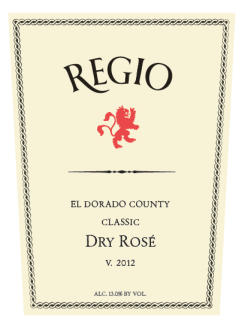

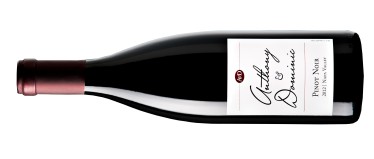
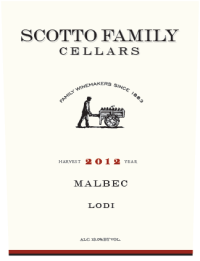
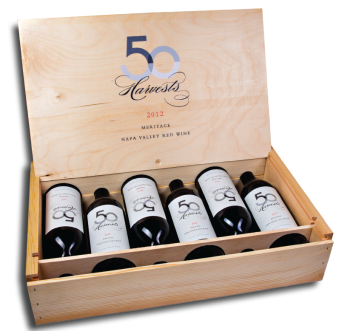
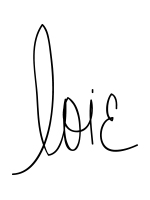
A great read and congrats on the well deserved win Loie! 🙂
LikeLiked by 1 person
Thanks Conrad! I appreciate the kind words and all the encouragement you have given me since I started blogging. Hope you got a chuckle or two. All my best, cheers! xo
LikeLike
Congratulations on winning The Drunken Cyclist’s Monthly Wine Writing Challenge #14!
LikeLiked by 1 person
Thank you! I am thrilled – that was more work than I anticipated. Whew. xoxo
LikeLike
Writing is not for sissies! I hope you had some good wine for both inspiration, and now, for celebration…. 🙂
LikeLiked by 1 person
Congratulations on your win, great job! 🙂
LikeLiked by 1 person
Grazie! Grazie! xo
LikeLiked by 1 person
You know I still have not opened the Rare Red 4 wine you recommended. Too much wine; too little time. Thanks for the backstory. Nice read! Oh and after my week in the greater LA area, the traffic is insane!!!
LikeLiked by 1 person
You have got to tell me what you think! Honestly – don’t hold back. I lived in LA for 12 years and it keeps getting worse and worse. SF unfortunately is not much better, but it is much prettier when stuck in traffic. Hope your tastings were fab – sad I missed you! xo
LikeLike
What a wonderful memory and a great discussion on tradition.
LikeLiked by 1 person
So glad you liked it – was a fun post to write – made drastic edits in the end to shorten the piece because there were so many great family stories – but what a good problem to have 🙂
LikeLiked by 1 person
Next month’s theme will be “Deadline”
LikeLiked by 5 people
If I bloody well win it shall be! Going to bed now….argh.
LikeLiked by 1 person
Reblogged this on mwwcblog.
LikeLiked by 2 people